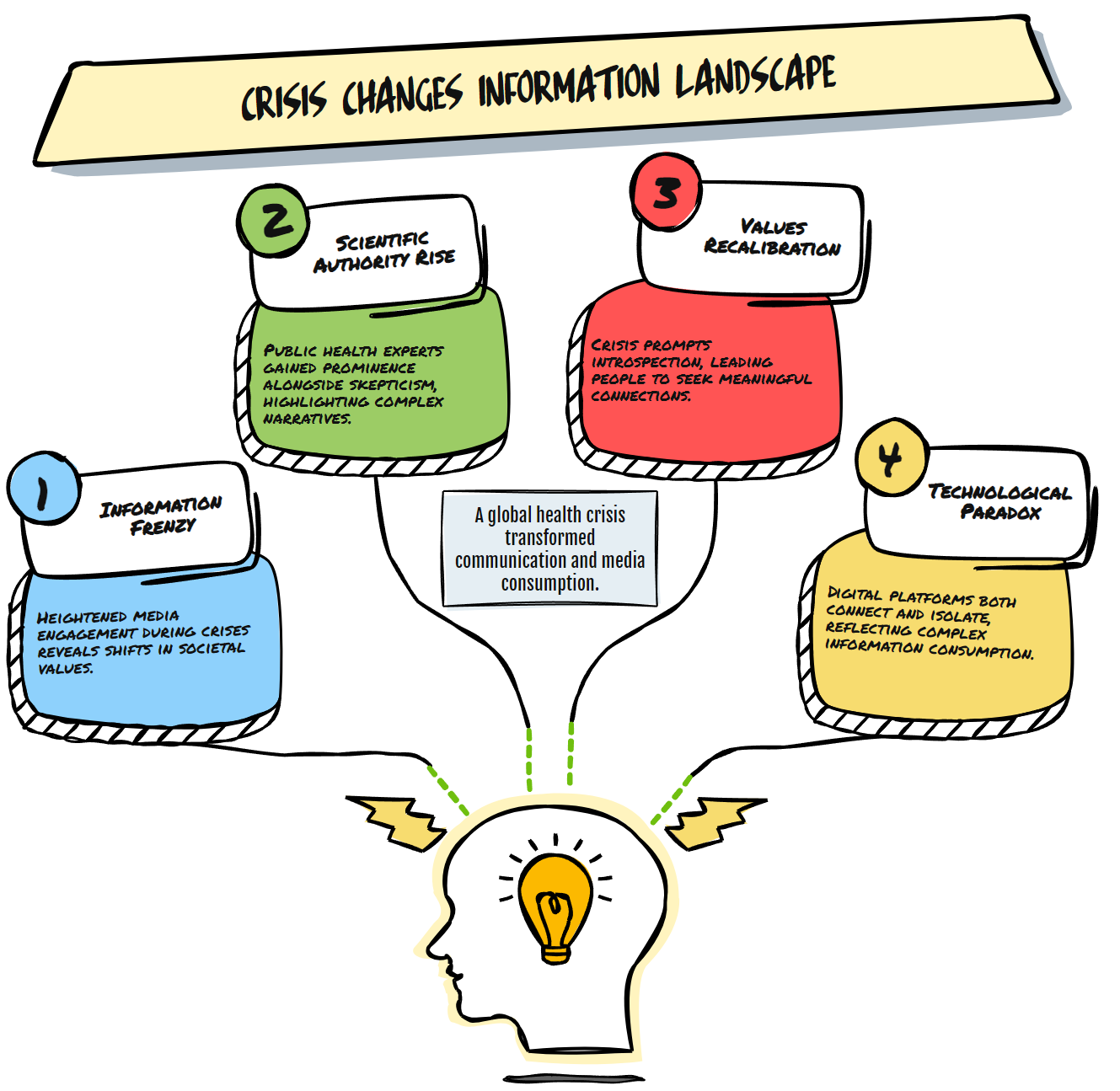
When Crisis Reshapes Our Media Landscape
When Crisis Reshapes Our Media Landscape
Truth finds us in crisis. When systems falter and certainties dissolve, we witness something remarkable about human communication. The recent global health emergency didn't just test our medical infrastructure or economic resilience. It fundamentally transformed how information flows through society, revealing more profound truths about what we value and how we connect.
The intersection of media evolution and public health crisis offers a unique window into our collective consciousness. As traditional channels buckled under unprecedented pressure, new patterns emerged that suggest a possible return to more transcendent values in our information ecosystem.
The Fracturing of Information Consensus
Before examining where we might be headed, we must acknowledge where we've been. The pre-crisis media landscape already showed signs of fragmentation. Echo chambers solidified. Trust in institutions eroded. The attention economy rewarded emotional triggers over substantive discourse.
Then came the global health emergency.
Almost overnight, information became both vital and volatile. Media consumption surged as people sought guidance, explanation, and connection. Yet this heightened engagement revealed profound fault lines in our information systems.
What emerged wasn't simply polarization but something more nuanced. We witnessed the simultaneous rise of scientific authority and scientific skepticism. Official channels gained viewers while alternative narratives proliferated. The same crisis that elevated public health experts also fueled conspiracy theories.
This paradox reveals something important about our relationship with information during a crisis. When stakes rise, so does our hunger for meaning beyond mere facts.
The Search for Deeper Narratives
As the crisis stretched from weeks to months, media consumption patterns made a subtle shift. Initial panic-driven news cycles gave way to something more reflective. People began seeking not just updates but understanding. Not just facts but frameworks.
Data suggests this wasn't simply fatigue. It represented a genuine evolution in information needs. Viewership for contemplative content increased. Philosophical discussions gained traction. Historical analyses of previous pandemics found new audiences.
This shift points toward what might be called a "values recalibration." When faced with fundamental uncertainty, people naturally gravitate toward more profound questions. What matters most? What connects us? What endures beyond immediate circumstances?
The media landscape, responsive as always to audience demand, began reflecting this shift. Platforms that once prioritized breaking news pivoted toward contextual analysis. Outlets known for partisan framing occasionally transcended their usual boundaries to address universal human concerns.
Technology as Both Barrier and Bridge
Throughout this evolution, technology played a paradoxical role. Digital platforms simultaneously connected and isolated us. Social media amplified both scientific consensus and fringe theories. Video conferencing brought us together while reminding us of physical separation.
This technological paradox mirrors a deeper tension in processing information during a crisis. We crave both immediate updates and timeless wisdom. We seek both scientific specificity and philosophical breadth. We want both practical guidance and transcendent meaning.
The platforms that thrived during this period recognized this duality. They provided factual clarity while acknowledging emotional complexity. They offered immediate utility while connecting to enduring values.
What emerged was not a rejection of technology but a more nuanced relationship with it. Users became more discerning about digital consumption. Many developed new habits around information hygiene, recognizing that what we consume shapes who we become.
The Return to Transcendent Values
Perhaps the most significant media trend during the crisis was the renewed interest in what might be called transcendent values. Stories of sacrifice, solidarity, and resilience gained unprecedented traction. Content exploring purpose, meaning, and connection found eager audiences.
This shift wasn't merely sentimental. It reflected a genuine recalibration of priorities when faced with mortality and uncertainty. Media that acknowledged this deeper dimension resonated most powerfully.
Interestingly, this trend crossed traditional demographic and ideological boundaries. Audiences that commonly consumed vastly different content found themselves drawn to similar themes. The vocabulary might differ, but the underlying values showed remarkable convergence.
This suggests something important about human nature. When stripped of everyday routines and confronted with fundamental questions, we often return to core values that transcend our differences. Media that recognized and reflected this reality found unexpected resonance.
Where We Go From Here
As we continue processing the impact of recent global events, the media landscape faces critical questions. Will the return to transcendent values persist, or will we revert to previous patterns? Can the lessons of crisis communication inform a healthier information ecosystem?
The answers remain uncertain, yet certain trends appear durable. Audiences have developed more sophisticated information filtering skills, and many have reconnected with deeper values that inform their media consumption. The relationship between technology and human connection has been permanently recalibrated.
What seems clear is that a crisis doesn't merely reveal weaknesses in our systems. It also illuminates possibilities for evolution. The media landscape from this period will likely reflect the exposed fractures and the rediscovered values.
The conversation continues. But perhaps now it includes more voices asking not just what information is accurate but what wisdom is enduring, not just what content captures attention but what communication nurtures our humanity.
In this evolution lies hope for a media landscape that doesn't merely inform but illuminates. That doesn't just connect us to current events, but to each other and to the transcendent values that make those connections meaningful.
